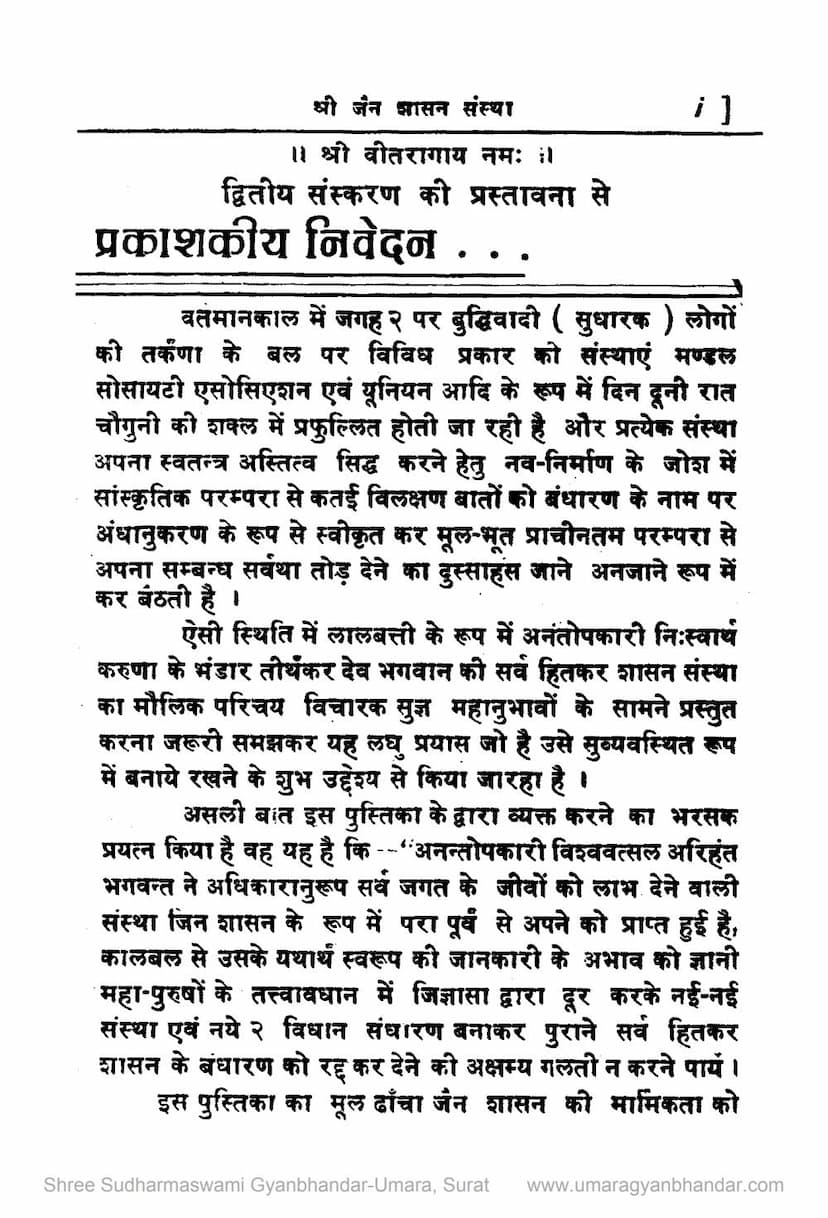Jain Shasan Samstha Ki Shastriya Sanchalan Paddhati
Added to library: September 2, 2025

Summary
This document, "Shri Jain Shasan Sanstha ki Shastriya Sanchalan Paddhati" (The Scientific Management System of the Jain Governance Institution), authored by Shankarlal Munot, is a comprehensive guide to the principles and practices of managing Jain institutions according to scriptural authority. It emphasizes the preservation of Jain traditions and the proper utilization of religious assets.
The book, which has gone through multiple editions due to high demand, aims to educate and guide Jain community members, especially those involved in managing religious institutions (Shri Sangh). It highlights the importance of understanding the foundational tenets of Jain governance, established by the Tirthankaras, and warns against deviating from these ancient traditions due to modern intellectual trends or blind imitation.
Key Themes and Content:
- The Essence of Jain Governance (Shasan): The text defines Jain Shasan as encompassing the eternal principles of Jainism (Ahimsa, Anekantavada, Aparigraha), the teachings and commands of the Vitaragas (Jinas), the community (Sangh) comprising the fourfold assembly (monks, nuns, laymen, laywomen), and the scriptures (Agamas). It also refers to the assets and wealth accumulated for the propagation of the faith.
- Historical Context and Founders: It identifies Rishabhdev as the first Tirthankara and founder of Jain Shasan in this evolutionary cycle, and Mahavir Swami as the founder of the current dispensation. It notes that Jain Shasan is destined to last until the end of the fifth era.
- Structure and Management:
- The Fourfold Assembly (Chaturvidh Sangh): This is identified as the primary operational body of the Shasan.
- Key Administrators: The text traces the lineage of leadership from Ganadharas to Acharyas, Upadhyayas, Ganis, and then to qualified lay followers who act as local representatives.
- Divine Guardians: It mentions the Yakshas and Yakshinis (Gomukh & Chakreshwari for Rishabhdev, Matang & Siddhayika for Mahavir) who are the governing deities of the Shasan.
- Sub-Institutions: Various Gachhas (sects) and local Shri Sanghs are mentioned as internal divisions of the Jain Shasan.
- Jain Shasan Assets (Sampatti): The book meticulously details the various types of religious assets:
- "Seven Fields" (Saat Kshetra): These include assets related to Jin Pratima (idol), Jin Mandir (temple), Samyak Gyan (right knowledge), Sadhus, Sadhvis, Shravaks (laymen), and Shravikas (laywomen).
- "Five Substances" (Paanch Dravya): Referencing the principle of collecting and utilizing spiritual assets (Dravya, Kshetra, Kaal, Bhav).
- Other Accounts: It includes various other religious funds like Guru Dravya, Sadhanik Vatsalya, Aayambil, Niviruta, etc.
- Management of Assets: The document provides detailed guidelines on the proper use of these religious funds, emphasizing:
- Strict adherence to scriptural rules: Emphasizing that the use of these funds is strictly governed by Jain scriptures and traditions.
- Prohibition of misuse: It strongly condemns using religious funds for personal gain, non-religious activities, or commercial ventures.
- Hierarchy of Funds: It explains the principle that funds from lower (less sacred) categories can be used for higher (more sacred) categories, but not vice versa.
- Specific usage rules: Detailed explanations are given for each category, including what expenses are permissible (e.g., idol maintenance, temple repairs, support for monks and nuns, scriptural studies, animal welfare) and what is prohibited.
- Charity vs. Religious Funds: It distinguishes between general charity (Anukampa) and specific religious funds, emphasizing that the latter cannot be used for secular charitable purposes unless explicitly permitted by scripture.
- Governance Principles:
- Authority of the Sangh: The ultimate authority rests with the Chaturvidh Sangh, guided by Acharyas.
- Rejection of Modern Governance Models: The book criticizes modern democratic practices like elections, majority rule, and public trust acts for potentially undermining the scriptural authority and traditional governance of the Jain Sangh. It argues that these methods can lead to the rise of power-hungry individuals rather than genuinely qualified and devoted individuals.
- Emphasis on Qualification and Tradition: It advocates for a system of selecting administrators based on their scriptural knowledge, adherence to tradition, and virtuous qualities, as outlined in texts like the Dravya Saptatika.
- Maintaining Tradition: It stresses the importance of not altering or creating new rules that contradict the established Shasan Maryada (Jain governance principles). Any modifications should be in line with the spirit of the scriptures and made with the guidance of learned monks.
- Specific Guidelines: The document includes specific directives on:
- Conduct during worship and religious practices: Detailing appropriate attire, behavior, and rituals for various religious observances.
- Temple maintenance and decoration: Advising against the use of inappropriate materials and modern electrical devices that might damage idols or disturb the spiritual atmosphere.
- Prohibition of certain practices: Condemning activities like using microphones during religious ceremonies (unless essential), celebrating late at night, playing cinema music, conducting women-only programs, using cameras, or consuming unwholesome food items during festivals.
- Appendices: The book includes several appendices that elaborate on specific decisions and guidelines, such as:
- Appendix 1: Details on the "Seven Fields" and their specific management.
- Appendix 2: Decisions from the Shraman Sangh at Palitana regarding government interference in religious matters and the ownership of Jain institutions.
- Appendix 3: An argument against election systems and a call for selection based on merit.
- Appendix 4: Guidelines for the management of religious affairs, particularly concerning "Dev Dravya" (temple assets) and "Gyan Dravya" (knowledge assets).
- Appendix 5: A framework for the constitution of a Jain Sangh, emphasizing scriptural adherence and qualified leadership.
- Additional sections: Include points on the purity of religious practices, guidelines for festivals, and a correction sheet (Shuddhi Patrak) for errors in the text.
In essence, "Shri Jain Shasan Sanstha ki Shastriya Sanchalan Paddhati" serves as a vital manual for upholding the sanctity and integrity of Jain religious institutions, ensuring that their management is always aligned with the profound and time-tested wisdom of the Jain scriptures and traditions. It aims to prevent the erosion of these principles in the face of modern societal changes and pressures.